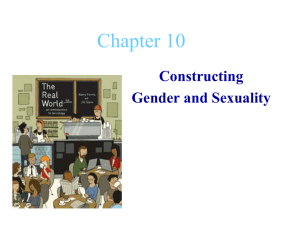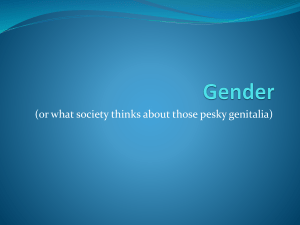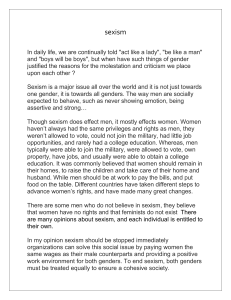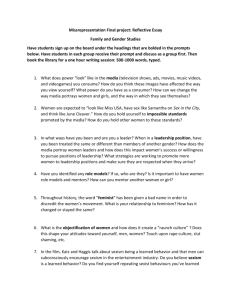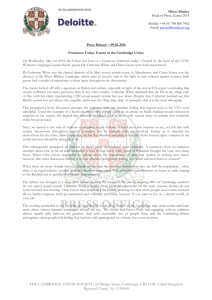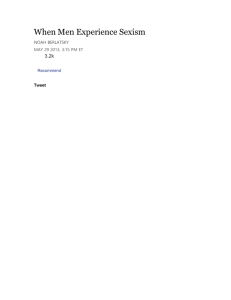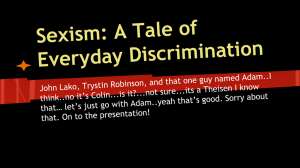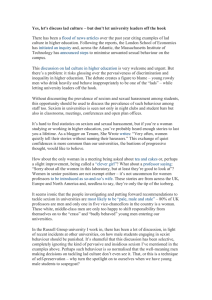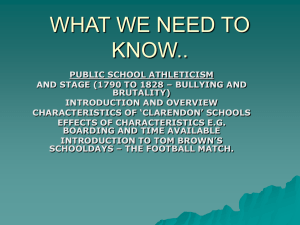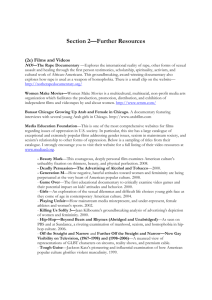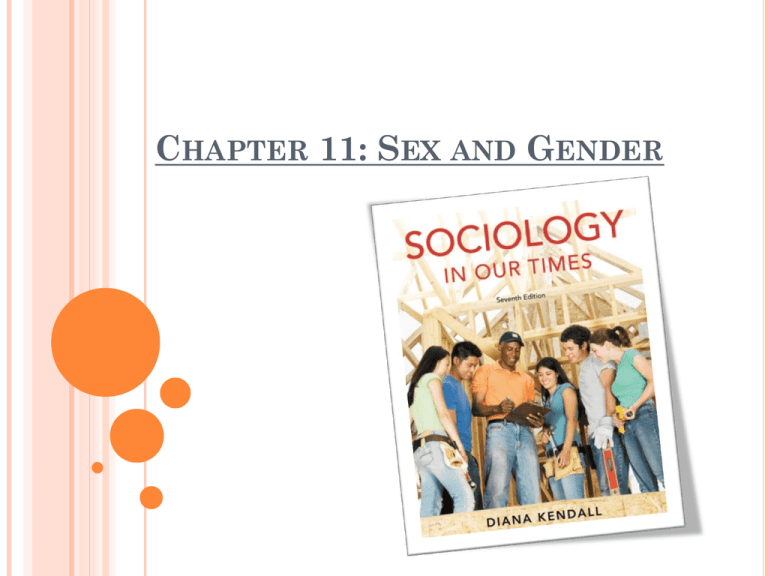
CHAPTER 11: SEX AND GENDER
SEX: THE BIOLOGICAL DIMENSION
Sex refers to the biological and anatomical
differences between females and males
Unlike gender, which is the culturally created
aspect (i.e. masculinity and femininity)
One’s sex is distinguished by two characteristics
Primary: The genitalia and reproductive processes
Secondary: The physical traits (other than reproductive
organs) that identify an individual’s sex
For example…well it’s pretty self explanatory…
Some sexual anomalies
Hermaphroditic births are when the differentiation of the sexes is
incomplete in a person…they tend to posses both primary parts
A Transsexual is a person whose identity concerning their
apparent sex is opposite from their primary features
SEX: THE BIOLOGICAL DIMENSION
(CONTINUED)
Three sexes!?!
Sort of, as oddly as it may appear to “Westerners” some
societies recognize three. The third in this case would be
berdaches, and the closest approximation of such is the
concept of the transvestite in Western culture.
A Transvestite is a male or female who lives as their sexual
opposite, without altering their primary features
Though technically not three, they often pass as members of that
sex
Sexual orientation
Refers to the individual’s preference for emotional-sexual
relationships with members of the opposite sex
(heterosexuality), the same sex (homosexuality), or both
(bisexuality)
Homophobia refers to the extreme prejudice, and often
violence, towards homosexuals or bisexuals (or simply, nonheterosexuals)
GENDER: THE CULTURAL DIMENSION
Gender refers to the culturally and
socially constructed differences between
females and males found in the meanings,
beliefs, and practices associated with
“femininity” and “masculinity”
Gender role: the attitudes, behavior, and activities that are socially
defined as appropriate for each sex and are learned through the
socialization process
Gender identity: is a person’s perception of the self as female or
male
Gender stereotypes
For men, “society” considers them to be strong, rational, dominant,
independent, and less concerned with appearance
For women, they are considered to be weak, emotional, nurturing,
dependent, and anxious towards appearance
The consequences of these stereotypes commonly results in anorexia,
bulimia, and body-building
SEXISM IN SOCIETY
Sexism is the subordination of one sex,
though predominantly women, and is
based on the assumed superiority of the opposite sex
As the cycle follows: negative attitudes, then stereotypical
beliefs, and finally discrimination
Sexism for men may be the notion that only men can serve in
the military; because the loss of a woman’s life is seen as a
greater loss than the man’s
Sexism is said to be interwoven with patriarchies and
matriarchies
Social organization and centrism around men, or women
(respectively)
Refer to Chapter 5 for a more in depth analysis of men’s and
women’s roles and statuses throughout the history of humanity
GENDER AND SOCIALIZATION
Boys
At birth: viewed as less
fragile, and often treated
more roughly
Boys’ toys tend to be
competition related, or
constructive
It is more stigmatized if a
boy were to engage in
“feminine” activities than
the inverse
Girls
At birth: viewed as cute and
cuddly, and often cared to
immediately when crying
Girls’ toys tend to be dolls,
make-up, and “artsy” items
Throughout their life they
are pressured more than
boys to look a certain way,
and thus prone to eating
disorders (more so than
boys)
Teachers and schools
Sports
For children, most of their non-school time is
spent playing. Male sports tend to be
aggressive, orderly, and competitive. Whereas
female sports tend to be small, sociable, and
lack competition
Having a sports and a social life can often be
conflicting, overwhelmingly so for female athletes
Mass Media
Often highly gender stereotyped, and becoming
increasingly prevalent.
MORE AGENTS OF GENDER SOCIALIZATION
Schools are a highly gendered institution, and
are subject to gender biasing (even if
unintentional)
A gender bias is showing favoritism to one
gender over the other
Things like sexual harassment are often
overlooked, as teachers adopt principles like
“boys will be boys”
From the “womb to the
tomb” both men and
women are (nearly)
constantly barraged with
what it means to be male
or female . As
Sociologists will point
out, over-stratification is
not necessarily a good
thing.
According to the
U.S. Bureau of
Labor and
Statistics (2004) for
every 100 cents
men make, women
make roughly 75
cents.
•
THE WAGE GAP
This graph is in
terms of the
percentage of that
100 cents.
•
As it turns out,
occupation is
regardless of these
trends.
•
GENDER STRATIFICATION: A SOCIOLOGICAL
PERSPECTIVE
Perspective
Focus
Functionalis Macro-level analysis of
t
women’s and men’s roles
Theory/Hypothesis
Traditional gender roles ensure
that expressive and
instrumental tasks will be
performed
• Human Capital Model
Conflict
Power and economic
differentials between men
and women
SymbolicFeminism should be
Interactioni embraced to reduce sexism
st
and gender inequality
Unequal political and economic
power heightens gender-based
social inequalities
1.
2.
3.
4.
Liberal Feminism
Radical Feminism
Socialist Feminism
Multi-cultural Feminism
REFERENCES AND
ACKNOWLEDGEMENTS
o
o
o
Sociology In Our Times (Seventh Edition)
o By: Diana Kendall
Notes incorporated
o By: James V. Thomas, NIU Professor (Emeritus)
o Formatted By: Jacob R. Kalnins, NIU student
Pictures Incorporated
o Clip Art (PowerPoint: 2007)
o Google Images: Sociology In Our Times

